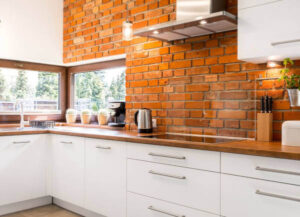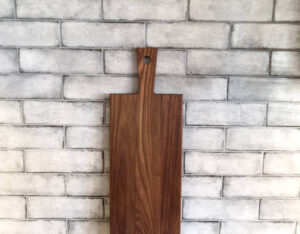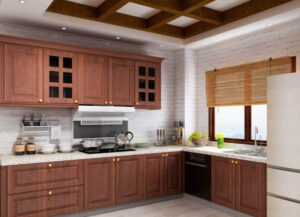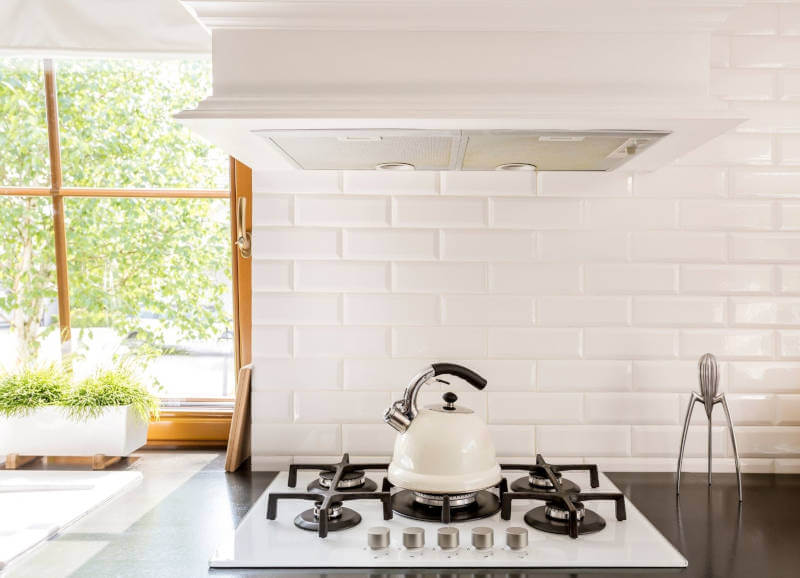So, you’ve got your brick backsplash completed, and you’re in love with the rustic charm it brings to your kitchen. But there is another step to the process, the sealing. So, how do you seal a brick kitchen backsplash?
To seal brick kitchen backsplash, the bricks need to be cleaned in preparation for applying the sealant. Scrub the bricks with a masonry brush and allow them to dry. Then apply the sealant with broad and overlapping strokes. Allow this to absorb for 5-10 minutes before wiping off any excess sealant.
The process of sealing a brick kitchen backsplash is quite simple. It’s important to follow the necessary preparation before sealing to make sure the sealant works properly.
How do you apply sealant to brick backsplash?
Applying sealant to brick backsplash involves cleaning the brick, applying it to the brick and leaving it to properly seal. Let’s look at the main steps to applying a sealant to brick backsplash.
Put on PPE gear to protect yourself when using sealant
Before you get any sealer out, you need to make sure you are protecting yourself from the possible effects of the sealant. Sealants of any kind are typically dangerous to inhale and can irritate the skin if contact occurs. Make sure you have the correct PPE gear to protect yourself when sealing a brick kitchen backsplash. You should have a respirator mask and keep a window open. This allows the sealant fumes to escape the house and not be inhaled. Inhaling sealant fumes can cause damage to the internal organs, similar to the effects of inhaling dust.
You should also do your best to cover your skin as much as you can. Sealants can cause damage to your skin, including irritation to the eyes, nose and throat. Wear coveralls if you can, but you should definitely wear gloves.
Finally, you should wear goggles to protect your eyes.
Clean the brick backsplash
Before you can apply a sealant to brick backsplash, you need to clean the brick. Without cleaning the brick backsplash, the sealant won’t adhere to the bricks properly. Give the bricks a good scrub with stone cleaner and medium poly brush to get rid of grime and other dirt build-ups. Let the brick backsplash dry before moving on to applying sealant.
Apply sealant to brick backsplash
To apply a sealant to brick backsplash, start by putting the sealant in a bowl or container large enough to dip a foam paintbrush into. Make sure you are decked out in all your PPE gear.
Using broad, overlapping strokes, start brushing the sealant onto the backsplash. It’s best to work from top to bottom, to prevent any dripping.
Depending on the sealant you are using, you may need to keep the surface wet throughout the process. You can dip a sponge in the sealant and continuously wipe the wall with that to do so. Read the instructions of the sealant you’re using to be sure of exactly how to keep the surface prepped while applying it.
Leave the sealant to absorb in brick backsplash, then remove excess
Once the backsplash is totally coated in sealant, let it penetrate the stone for 5-10 minutes. Then, take a clean cloth and remove the sealant that hasn’t been absorbed. You’ll need to be somewhat quick here to prevent it from hardening too much. Rub in a circular motion until the bricks are dry and smooth.
Keep buffing until the wall is smooth and the sealant doesn’t feel tacky. If you follow all these steps, your brick kitchen backsplash will be thoroughly sealed!
How do you clean brick before sealing?
To ensure your brick backsplash seals properly, you need to clean the bricks before applying the sealant. If there are lots of contaminants on the surface, the sealant won’t be able to absorb into the brick properly.
To clean a new brick backsplash, you can use lightweight cleaners. A simple, ready to use tile and stone cleaner will do a great job. Simply spray the whole brick backsplash with the product. Then use a soft sponge or coco fibre brush to scrub the wall from top to bottom.
If the kitchen backsplash is older and the bricks have been exposed to more cooking, they will have more grout haze build-up. This is when you will want a more heavy-duty cleaner to clean the brick backsplash before sealing. There are many heavy-duty masonry cleaners to choose from. Make sure you don’t use an acid-based cleaner. These aren’t designed for masonry tasks and can damage the surface of the brick backsplash. The cleaner you use to prepare brick backsplash for sealing should have neutral ph.
What to put on bricks to seal?
 To seal a brick kitchen backsplash, you need a sealant that is both oleophobic and hydrophobic. This means it will repel both water and oil – essential for brick backsplashes in a cooking area. This will ensure the bricks are protected against cooking stains and substances such as oil, water, sauce, and more. The common choice of sealant for brick backsplash is a clear polyurethane sealant. Polyurethane sealant works to keep moisture, air, oil, and cooking stains and fumes out of bricks.
To seal a brick kitchen backsplash, you need a sealant that is both oleophobic and hydrophobic. This means it will repel both water and oil – essential for brick backsplashes in a cooking area. This will ensure the bricks are protected against cooking stains and substances such as oil, water, sauce, and more. The common choice of sealant for brick backsplash is a clear polyurethane sealant. Polyurethane sealant works to keep moisture, air, oil, and cooking stains and fumes out of bricks.
There are lots of sealant brands to choose from. The key point is to make sure that whichever sealant you choose, is oleophobic and hydrophobic. Any clear, polyurethane sealant will seal brick kitchen backsplashes without any worries. It will easily manage to get into the brick pores and seal properly to protect the kitchen backsplash.
Clear sealant is the best way to make sure that the sealant doesn’t change the appearance of your brick kitchen backsplash. There are different finishes you can choose from if you want to change the backsplash a bit. You can pick between a matte or gloss finish, depending on the sealant and appearance you want to achieve.
When you prepare properly and follow the few steps to seal your brick backsplash, the task seems fairly easy! Be sure to always put your safety first and wear the right protective gear when working with substances such as sealant. Remember, if you don’t properly prepare your brick backsplash for sealing, the sealant won’t work properly. But, by following our advice in this guide, you should have no issues with sealing your brick kitchen backsplash!
If you’re looking for quality bricklaying and masonry tools, check out our products at Paragon Tools! If you enjoyed this article, check out some of our others such as ‘are brick houses colder in winter?’



